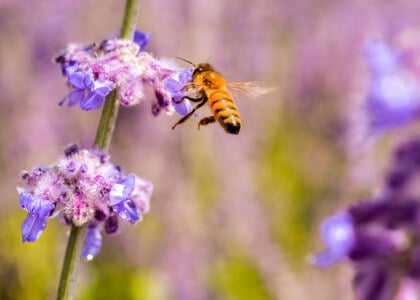Pollinators frequent many plant types, but there are some key characteristics that increase the odds that pollinators will call your garden home. You can support pollinators – and enjoy their activities – by choosing plants with qualities they prefer:

Left: Shasta Daisy, top right: Goldfinger Potentilla, bottom right: Walker's Low Catmint
Bright blooms – Pollinators don’t limit themselves to specific colors, but research proves what gardeners have known for years. Bright flower colors, such as white, yellow, red, orange and purple, draw pollinators near. The sparkling white blooms of Daisy May Shasta daisy are early summer favorites. From June into fall, the large bright-yellow flowers of Goldfinger potentilla and the purple-blue blooms of Walker’s Low catmint, rank high on pollinators’ lists, too.

Left: Ruby Voodoo Rose, top right: Bouquet Blanc Mockorange, bottom right: Red Charm Peony
Inviting fragrances – Floral scents can play a large role in drawing pollinators – and people – to plants and gardens. The double white blooms of Bouquet Blanc mockorange fill the air with an orange-scented invitation as summer approaches – perfect alongside the compelling scent of Red Charm peony. Fragrant roses are irresistible. Try the highly fragrant Ruby Voodoo rose. Its deep magenta blooms welcome pollinators from June until October each year.

Friendly shapes – Pollinator-friendly shapes make it easier for pollinators to get what they need from blooms. Butterflies prefer shallow, open-faced flowers that make landing and nectar sipping simple, like the intense, purple-pink summer blooms of Pixie Meadow Bright coneflower and fall’s deep purple Purple Dome aster flowers. Hummingbirds, on the other hand, can handle trumpet-like shapes, such as the summer-long flowers of Dropmore Scarlet honeysuckle vine and Trumpet vine’s brilliant orange, late-summer blooms.

Native roots – Peak activity by native bees naturally coincides with native plant bloom times. By incorporating varieties of native plants into your landscape, you provide timely support for native bees. Nectar-rich, cherry-red flowers of Pardon My Cerise beebalm combine beautifully with the purple bottlebrush spikes of Blazing Star liatris and the yellow flowers of Deamii black-eyed Susan for a mini-meadow effect native pollinators love.
When gardening for pollinators, remember plants aren’t all they need. These simple tips can help you meet other pollinator needs:
- Provide a water source, such as a bird bath or shallow saucer.
- Create pollinator areas with sun, shade and shelter from winds.
- Include a few sun-drenched warming stones for butterflies.
- Group plants together so pollinators can forage easily.
- Choose plants with varied heights and staggered bloom times to provide season-long food.
- Incorporate butterfly houses and bee hotels.
- If you use pesticides, limit them to evening hours when pollinators are less active – and always avoid spraying open blooms.
By hanging out the “Pollinators Welcome” sign, you can turn your landscape into the neighborhood’s pollinator hot spot. Shop our plants online and get growing now with pollinator plants and more. Need a hand making it happen? We’ve got you covered with design, installation and maintenance. And don’t forget to join us for fun on Facebook and Twitter, too.

